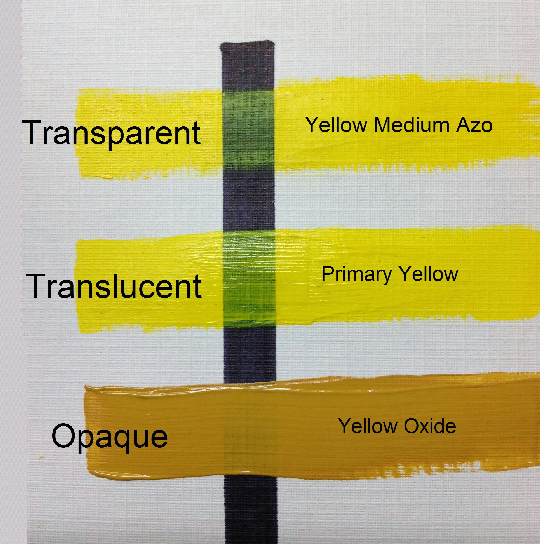An important characteristic of each pigment is whether it is translucent, transparent, or opaque. Knowing this characteristic for each pigment used is crucial for the serious artist to achieve the results desired. Some tubes of paint have this information printed on the tube itself. For pigments that are lacking this information, an easy test can be performed.
To determine translucency, transparency, or opacity of a pigment:
1) Simply draw a waterproof black line on a watercolor paper. A waterproof magic marker will do just fine.
2) Now apply a thin layer of your pigment over the black line.

If the black line appears sharp and dark, the pigment is transparent. This pigment allows the light to travel through the layer of paint.
If the black line is partly covered, the pigment is translucent (semi-transparent or semi-opaque). This characteristic absorbs much of the light but not all.
If the black line is covered, it is opaque. The pigment allows the light to only penetrate a short distance into the pigment.
The important thing to remember is that when a transparent hue is mixed with an opaque, the end result is MUD!
The best analogy I have found to describe what happens when a transparent is mixed with an opaque is a hot cup of tea! Let’s assume you have a hot cup of tea in front of you. It’s a transparent brown.
Ø Add some golden honey, which is another transparent, the tea transparency is not affected. It may be a warmer brown due to the honey color, but still is transparent.
Ø Add some milk, which is opaque, to the transparent tea, and suddenly the tea becomes muddy; a light brown hue where no light passes through.
The same concept goes for paint. If you want to paint over a layer and still see the underlying colors, it’s important to choose transparent colors. If you need to cover, use an opaque. It sounds too simple, doesn’t it? But many novice artists eager to just start painting overlook this important characteristic of each hue. What they unintentional create is mud!
So check out your pigments and paint smarter with transparent, translucent, and opaque paints. It opens a whole new dimension of painting! What sheer fun!